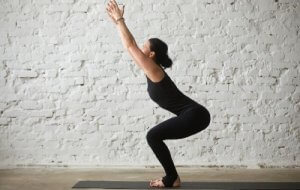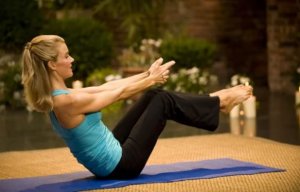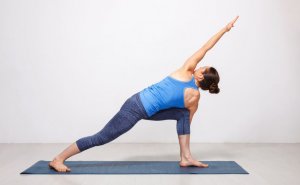Yoga Poses: Four Underused and Beneficial Poses

The ancient discipline of yoga offers a variety of health benefits. However, classes that perform the same yoga poses over and over again, can become monotonous. In this article, we’ll tell you about some of the most underused yoga poses. So you can add them to your routine today!
Which underused yoga poses are the most beneficial?
You may be familiar with some of the most common yoga poses, such as the downward dog and the cobra? But there are so many more, each with their own benefit. Let’s take a look at some of the most underused poses you should add to your routine, especially if you practice yoga at home.
1. Half-moon pose
It’s name in Sanskrit is Ardha Chandrasana, and although it’s not the easiest pose, it offers a variety of worthwhile benefits. It strengthens the ankles, the thighs, the spine, and the abdomen. It also improves coordination and balance, while alleviating stress and promoting healthy digestion.

To do the half-moon pose, stand up and move your right leg one step to the right. Raise your arms to shoulder-height. Gradually lean your torso to the left. As you lift your right leg off the ground, bring your left hand closer to the floor.
The idea is that the left foot and left hand serve as your two points of support. The right leg should remain in line with the body; the arm perpendicular to the floor, while the head faces the ceiling.
2. Revolved side angle pose
This is another underused yoga pose that offers real benefits. Any twist asana is great for improving the health of the spine, while allowing for deeper and more conscious breathing.

Originally named Parivrtta Parsvakonasana, you begin this pose with your knees on the ground. Then, lift your right leg and bring it forward, in order to place the sole of your foot on the ground. Your toes on your left foot, will also provide support.
Bring both hands together in front of your chest with your elbows pointing outwards. Now comes the twist: turn your torso to the right and lean your right elbow on your right side. The head is supported by the hands and the left elbow is raised above the head.
3. Boat pose
Called Navasana in Sanskrit, this pose is actually featured in many classes, but it’s not always a part of people’s regular yoga practices. It does, however, have many benefits. It strengthens the abdominal muscles, the hips and the back, tones the arms, and improves coordination, attention, and concentration. It also promotes the proper function of your internal organs.

There are a number of variants, but the most common pose is as follows: sit on your mat with your back straight and your legs stretched out in front of you. Bend your knees slightly and support the soles of your feet with your hands.
From your knees to your heels, the legs should say parallel to the ground, as should the arms, which stretch out in front of the body. The head and torso are held in a diagonal position, as are the thighs.
4. Chair pose
Utkatasana is another yoga pose that you should add to your routine. It allows you to burn fat and calories, much faster than any other physical activity, while also toning the legs and the glutes. Meanwhile, it strengthens the back, improves balance, and corrects flat feet.
In order to perform the chair pose, you need to stand with your legs together. Lift your arms and stretch them over your head with your fingers pointing upwards. Lightly bend the knees, stick your glutes out, and move your shoulders back. The head should point up, so you’re looking at the ceiling.
These four yoga poses are highly beneficial, even if they’re not among the most commonly practiced. Don’t hesitate to add them to your routine.
The ancient discipline of yoga offers a variety of health benefits. However, classes that perform the same yoga poses over and over again, can become monotonous. In this article, we’ll tell you about some of the most underused yoga poses. So you can add them to your routine today!
Which underused yoga poses are the most beneficial?
You may be familiar with some of the most common yoga poses, such as the downward dog and the cobra? But there are so many more, each with their own benefit. Let’s take a look at some of the most underused poses you should add to your routine, especially if you practice yoga at home.
1. Half-moon pose
It’s name in Sanskrit is Ardha Chandrasana, and although it’s not the easiest pose, it offers a variety of worthwhile benefits. It strengthens the ankles, the thighs, the spine, and the abdomen. It also improves coordination and balance, while alleviating stress and promoting healthy digestion.

To do the half-moon pose, stand up and move your right leg one step to the right. Raise your arms to shoulder-height. Gradually lean your torso to the left. As you lift your right leg off the ground, bring your left hand closer to the floor.
The idea is that the left foot and left hand serve as your two points of support. The right leg should remain in line with the body; the arm perpendicular to the floor, while the head faces the ceiling.
2. Revolved side angle pose
This is another underused yoga pose that offers real benefits. Any twist asana is great for improving the health of the spine, while allowing for deeper and more conscious breathing.

Originally named Parivrtta Parsvakonasana, you begin this pose with your knees on the ground. Then, lift your right leg and bring it forward, in order to place the sole of your foot on the ground. Your toes on your left foot, will also provide support.
Bring both hands together in front of your chest with your elbows pointing outwards. Now comes the twist: turn your torso to the right and lean your right elbow on your right side. The head is supported by the hands and the left elbow is raised above the head.
3. Boat pose
Called Navasana in Sanskrit, this pose is actually featured in many classes, but it’s not always a part of people’s regular yoga practices. It does, however, have many benefits. It strengthens the abdominal muscles, the hips and the back, tones the arms, and improves coordination, attention, and concentration. It also promotes the proper function of your internal organs.

There are a number of variants, but the most common pose is as follows: sit on your mat with your back straight and your legs stretched out in front of you. Bend your knees slightly and support the soles of your feet with your hands.
From your knees to your heels, the legs should say parallel to the ground, as should the arms, which stretch out in front of the body. The head and torso are held in a diagonal position, as are the thighs.
4. Chair pose
Utkatasana is another yoga pose that you should add to your routine. It allows you to burn fat and calories, much faster than any other physical activity, while also toning the legs and the glutes. Meanwhile, it strengthens the back, improves balance, and corrects flat feet.
In order to perform the chair pose, you need to stand with your legs together. Lift your arms and stretch them over your head with your fingers pointing upwards. Lightly bend the knees, stick your glutes out, and move your shoulders back. The head should point up, so you’re looking at the ceiling.
These four yoga poses are highly beneficial, even if they’re not among the most commonly practiced. Don’t hesitate to add them to your routine.
This text is provided for informational purposes only and does not replace consultation with a professional. If in doubt, consult your specialist.








